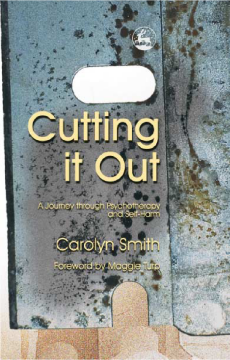
Additional Information
Book Details
Abstract
Cutting it Out is a largely autobiographical account of a young woman's battle with self-harm.
Carolyn's story documents her own challenging journey, offering unique insights into her feelings about self-harming and also her attitudes towards the therapy sessions commonly employed to help people who self-harm. It explores the complex nature of her relationship with the therapist, her initial resistance to recovery and her eventual progression towards self-knowledge and taking responsibility for her own actions.
The first-person narrative offers a vividly honest voice to the feelings and compulsions that drive someone to harm themselves and explores the conflict between the desire to self-harm and the struggle to control and overcome this addictive, self-destructive behaviour.
This timely book breaks the silence surrounding a difficult subject. It will provide valuable insights for therapists, counsellors, people who self-harm and their families and friends.
Carolyn Smith was educated at the University of Derby and University of Wales and is a qualified librarian. This is her first book, which is inspired by her own experiences of psychotherapy and self-harm. She currently lives in London with her partner and three cats.
`My room is untidy. By my bed a pile of books and newspapers is used as a handy table for three empty mugs of tea and a plate of toast crumbs. By the side of the `table' is a box of tissues and underneath the first layer of tissues is my secret stash of razor blades.' - Cutting it Out
'This book documents Carolyn's difficult journey to recovery. An honest and often candid portrayel of what drives an individual to self-harm. It shows how therapy can provide the answers needed to confront the compulsion.'
Inside Out
`This book is beautifully written, easy to read, and most importantly takes the reader into the main character's mind in an accessible way. The main character's thoughts and feelings are presented in a respectful but amusing way which allows both the character and reader to see mental health issues as a normal and integral part of everyday life.'
Safe The Domestic Abuse Quarterly
`Cutting It Out is Carolyn Smith's first book, and - inspired by the author's own experiences of self-harm and psychotherapy - tells the story of a young woman's struggle to overcome her compulsion to cut herself by undertaking therapy…The story is cleverly told by a present-day narrative, childhood flashbacks, and snippets of dreams and fantasy. It delves into her darkest thoughts - voices and visions which compel her to self-harm, and to try to contact with her therapist outside of their scheduled appointments…Overall, this novel offers insights into the benefit of therapy and the advantages of helping her to accept responsibility for her actions, and seeking her own solutions for alternative coping methods. It would interest both people who self-harm and those involved in their care.' - Safer Custody News
`This book is also useful for those working with women who are dealing with issues of anger and control as it addresses, from the main characters perspective, the relationship and therapeutic boundaries between therapist and client. Due to the increase in self-harming and the links which we know exist between self harm and domestic violence we highly recommend this book as an excellent resource for both domestic violence service providers and users.' - The Women's Aid Federation
`Cutting it Out is an intriguing detective novel in which a young woman discovers why she cuts her flesh. Her self-attacks, seemingly so incomprehensible and inhuman, cannot withstand the hidden truths that emerge from the deepest layers of her mind. Cleverly crafted and well-written, the novel is a realistic and solid read.'
Armando Favazza MD, author of Bodies Under Siege and Professor of Psychiatry, University of Missouri
Table of Contents
| Section Title | Page | Action | Price |
|---|---|---|---|
| Book I | |||
| 1 Roots of this method | |||
| 2 Survey for generative themes | |||
| 3 Problem-posing materials | |||
| 4 Adult learning and literacy training | |||
| Resources | |||
| Book II | |||
| 5 Trust and dialogue in groups | |||
| 6 Leadership and participation | |||
| 7 Simple decision-making and action planning | |||
| 8 Evaluation | |||
| Book III | |||
| 9 Global- Local Analysis | |||
| 10 Building a movement | |||
| 11 New forms of management and supervision | |||
| 12 Planning workshops | |||
| Index |
